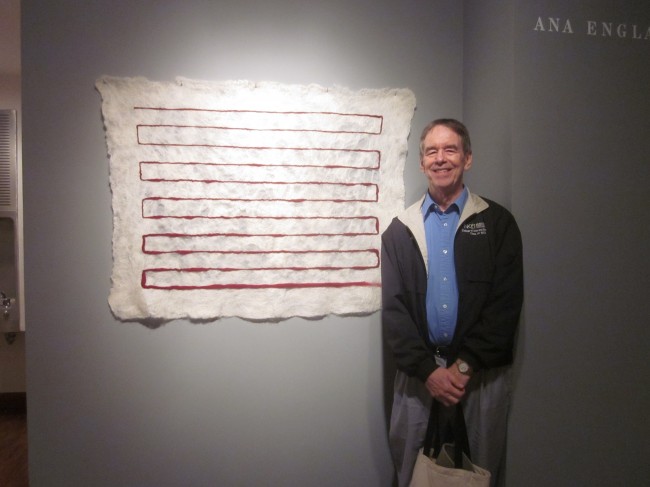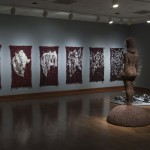Letter from Bellevue: Red-Line Elegy
By Robert K. Wallace
It was a typical Friday night. Immediately after dinner I was going to drive into Cincinnati over the Big Mac Bridge, check out the show at the Weston Gallery near the Aronoff, drop in at Hewett Gallery near the Pendleton, and then head up to the Bow-Tie Café on Mt. Adams to hear some favorite students read their poetry. The evening turned out differently than I had planned.
It was already dark and rainy when I left my house, but that did not prepare me for the glare of the large emergency vehicle blocking the right lane of the ramp leading down onto Sixth Street near the P&G Towers. I could not see why it had stopped there, as its bright red lights in the pitch dark night made it hard to see where I was going or if any emergency workers were out on the ramp. When I got to the red traffic light at Broadway it was still difficult to know what was happening because the road was blocked to the left, with two police cars near the barrier, making me finally remember that this was the first night of Octoberfest. I crept through the intersection when the light finally changed and slowly drove the length of Sixth Street to Elm, passing the construction fences at Sixth and Race, thankful I had hit no pedestrian on this dark, ominous night.
After taking Elm to Seventh and pulling into the old Shillito’s parking garage at Vine, I was happy I had brought my umbrella for the short one-block walk to the Weston. The umbrella was absolutely dripping by the time I stepped into the Gallery and saw some good friends who were now already on their way to the Hewett Gallery. Heading straight downstairs to see the works by Ana England and Steven Finke, I was brought up short by the gleaming high metallic tower supporting something softer up on top. There was an excellent crowd in spite of the weather as I slowly strolled through Steven’s installation in the front room before moving to Ana’s in the back.
The first thing I noticed in Ana’s part of the show was the large rectangular fabric before you turned the corner on the left, a vertical white field threaded with a long red line that took a right-angle turn before each horizontal run across the supporting ground. Around the corner, I was drawn to a longer and narrower field of white, horizontal this time, its red thread bunched into the calligraphic message of some voice distant in space or time now suddenly right here with us. This led me to the back left wall where I was mesmerized for I don’t know how long.
First, it was simply the color and texture of these seven vertical designs, each floating a soft, thin, partly transparent white fabric over a field of slightly denser, rich red, its fabric open enough to show the strong black fabric beneath the other two, the black layer open enough to reveal glimpses of the wall of the gallery supporting the shiny metallic needles over which each fabric stack hung. My first impulse would have been to touch each colored fabric, to see how it felt. But then, for me, the layering took over. First, the color against color in each vertical design. Then the presence against absence within each color field. And then, especially, the presences and absences among all three layers, these static patches of colored fabric hanging from shiny needles fixed in the wall suddenly pulsating in a surprising dance of motion and, one felt, somehow, emotion.
Each of the seven hangings differed from the others in the shape of the white that floated over the red and the black, so I spent a good deal of time with each before I went on to the rest of the show. In the center of the room was the life-size ceramic sculpture of a female body stuck with metallic needles that I thought might symbolize acupuncture. On the wall opposite the one I had been studying were a series of fabrics in the shape of the female form but in subtly contrasting texture and color, as if to suggest differing cultural practices in preserving the dead. One reminded me of mummies, another of catacombs whose bodies are slowly being covered by a soft white growth.
Leading out of the large back room was another large vertical design of white fabric threaded with red. Out around the corner was a white ground of fabric through which ran a continuous blue-green line whose horizontal path and right-angle turns matched that of the red-on-white pattern, directly across from it here at the entrance of Ana’s show.
The artist had been speaking with a number of friends and admirers in small groups as I took my tour, and I had not wanted to interrupt. She was now free at just the right time so I got to retrace my tracks in her company. I told her the horizontal red threads running at right angles through the bright white ground had somehow reminded me of the red lines of the heartbeat monitor for my friend Danny Miller when I saw him in the hospital for the last time, dying of a sudden heart attack. Her red line, Ana explained, was the same. This whole series, in which she was working in fabric for the first time, had been prompted, and inspired, by the death of her dear mother.
I had sensed that there was some kind of progression in the sequence of seven white fabrics over seven red and black ones on the far left wall. I had noticed that the white overlay had become thinner in texture and more open in design in moving from left to right. Now, standing with Ana, they seemed to embody nothing less than the passage from life to death as the white got smaller, showing more and more of the red, with the red itself also becoming more open and transparent until the ultimate function of each seemed to be to emphasize the all-compassing nature of the deep, black ground. If this was indeed the sequence, the white would represent the body, the red the blood, and the black the rest of death.
As I was slowly floating this theory to Ana, she said that her intentions in designing this sequence had been essentially the same. She said it had taken her forever to find just the right color of red, ordering samples from all over the country. The medium is felted wool, a fabric that is amazingly strong while also light and malleable. Yes, she said, the needles in the sculpted woman did represent acupuncture. And actually, she said, those female fabric shapes on the opposite wall were all shaped from that same female sculpture. And not only that, they could be taken off the wall and worn, as she now demonstrated for me against her own figure. In her mind they represented not so much other cultures as the selves we each slough off in the process of living and dying.
As we came out of the back room, she explained that the blue-green line running through the white field at the entrance represented the line that had monitored her mother’s breathing, as opposed to the red line tracing her heart beats on the opposite wall. I felt so blessed to have had this conversation with her, and to discover that her abstract art had evoked deep responses in me very similar to the much deeper experience in her life that had impelled her to create these works. I told her I could not quite make out the softer offering up on the top of the tall metallic tower I had seen at the foot of the stairs, and she said it was the hair she had harvested from her own head and those of her sisters as their mother was dying.
It was still dark and nasty when I left the Gallery, but I was calm and excited in the best possible way, so I left my other destinations for future Friday visits, inching slowly through all the traffic bunched up for three red lights at Fifth and Race to find a bridge back over the river. Safely at home in Bellevue, I had time to think a bit about what I had seen and felt.
I have seen every faculty show Ana England has given since arriving at NKU. We are colleagues; Ana teaches art, and I, English. I remember taking my aunt from California up to a show she had at Miami University in Oxford. Last year I had a semester of committee meetings in the room in our Science building whose transparent windows are laminated with Ana’s bone white organic designs. Every time I eat in the Cincinnati Art Museum café I ask for a table where I can see her elegant serpentine cosmic curl. She never repeats herself and never wastes a motion. But what does her art reveal about abstraction and emotion?
I had not read any labels or captions when seeing her show, so everything I felt came in response to the objects themselves. Her use of shape, line, texture, medium, and design in each successive piece invited me to make my own meaning from what I saw and felt, meaning deeply enriched, of course, by the opportunity to speak with her about her processes and certain of her intentions. So much of what we encounter in our culture today is prepackaged and oversold. That too often includes prepackaged and oversold emotion and even grief. How refreshing to be able to discover through one’s own viewing process some of the meaning an artist has herself created, and found, through her own creative practice.
The church I attend in Covington has a Prayer Shawl Ministry whose volunteers create comforters for individuals who have lost a loved one, are in pain, or are awaiting a new birth. I have encouraged its members to visit the Weston Art Gallery before the current show closes on the First Sunday of Advent.
Robert K. Wallace is Regents Professor of English at Northern Kentucky University.
The exhibition Ana England & Steven Finke: Imminence is at the Alice F. and Harris K. Weston Art Gallery in Cincinnati from September 20 – December 1, 2013.
- England, Ana and Steven Finke – Bier with Shroud, 2013, 156 x 80 x 54
- England, Ana – Elegy, Witness, Condition (l-r)
- Bob with Red Line
Individual works discussed in this essay include Red Line, Red Line 3, Elegy (7 elements), Witness, Slough (5 elements), Red Line 2, Blue Line, and Bier with Shroud.









